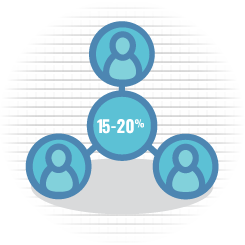
PMPs: Leveraging Second-Party Data for Digital Campaigns
In the first installment of this series, First-Party Data: A Hidden Gem for the Post-Cookie World, we looked at how an advertiser’s customer database, or first-party data, can be used for advertising purposes. Now we will expand to the world of data sets that you can leverage to help increase, and refine, your first-party data while generating awareness and preference in the pursuit of sales.
Suppose your most desirable customers tend to read either New York Times or People Magazine online. You could just place advertising on either NYTimes.com or People.com, but that would result in a lot of wasted impressions, served to those who might not be aligned with your product or service. How do we minimize that waste? That is where second-party data comes in.
Second-Party Audience Buying: What is It?
I am referring to “second-party” here as the audience data of online publishers and other media properties like ad networks. The data is theirs — not yours — hence the second-party designation. Their audience data really is comprised of multiple audience segments, with data points that result in profiles that may look like your desired customers. If you are a CPG company, you may want to target those who are buying your competitive set in the hopes of converting a percentage of those to buy your brand. If this is the case, your criteria may include reaching those who:

Match your geographic distribution area

Are within your desired customers’ HHI range

Shop at a specific
set of retailers

Are any combination
of the above
This approach allows an advertiser to use a media property’s larger audience set, minimizing waste while adding new users who can eventually grow your first-party data. You are not on NYTimes all the time, just when your target audience happens to be viewing. With apologies to the late Rod Serling, you’ve now entered the world of the Private Marketplace (PMP).
The Private Marketplace: How Second-Party Audience Buying Gets Done
Unlike the large ad exchanges that utilize available inventory from thousands of sites, the private marketplace allows an advertiser to programmatically buy only the audience they desire to target within a restricted set of one or more sites. Working with a publisher PMP allows for buying select audience segments that match up with an advertiser’s desired audience data, as noted above. Some things to consider when working with PMPs:

Make sure that there is already alignment with your audience. For example, you may not want to use a particular PMP if less than 5% of your desired audience is going to a specific site or series of sites within that PMP. Consider 15% – 20% or more as a good guideline.

Think beyond “open web” display banners. Can you reach a publisher’s in-app or social media users? While there might be additional premiums for these, the additional costs may be justified if your desired audience is engaged with these platforms.

Balance a PMP buy with other tactics for overall efficiency. No one tactic can serve every marketer’s objectives. Remember that the key is to test and see if this approach works within a selection of tactics that meet your overall parameters for effectiveness and efficiency.
With the era of cookie-less advertising fast approaching, using PMPs to access second-party data will likely become a viable option to not only enhance campaign performance, but grow your customer base as well.

